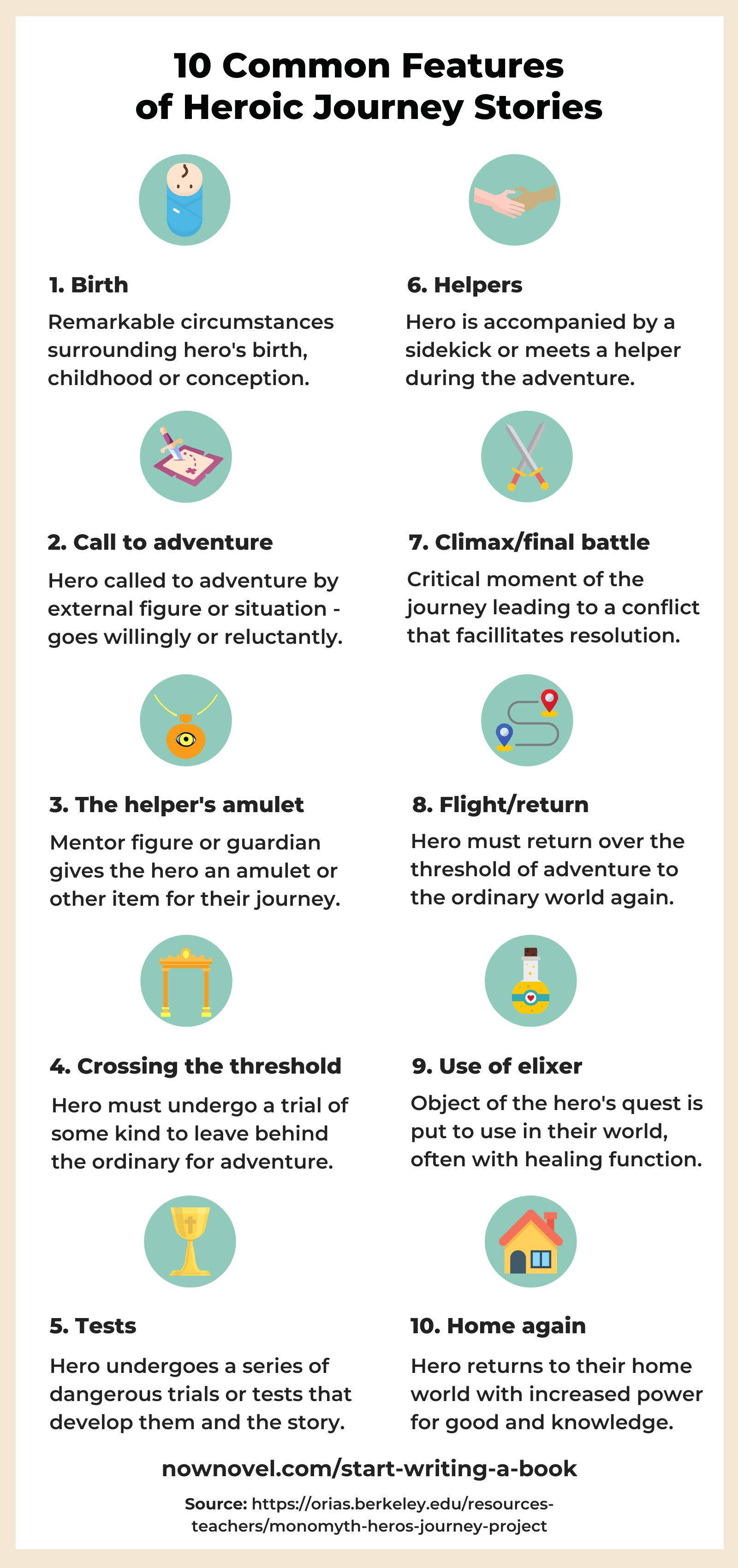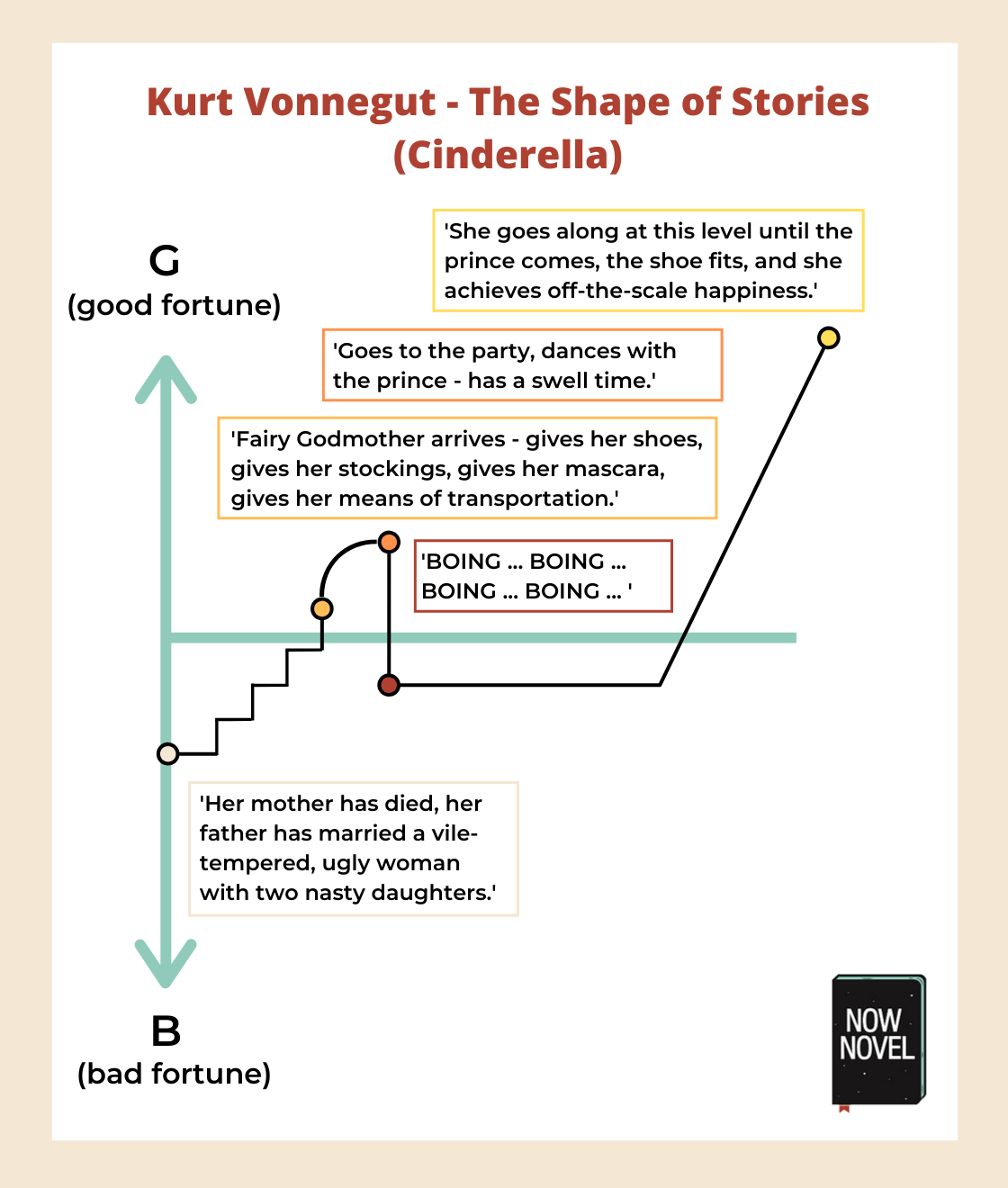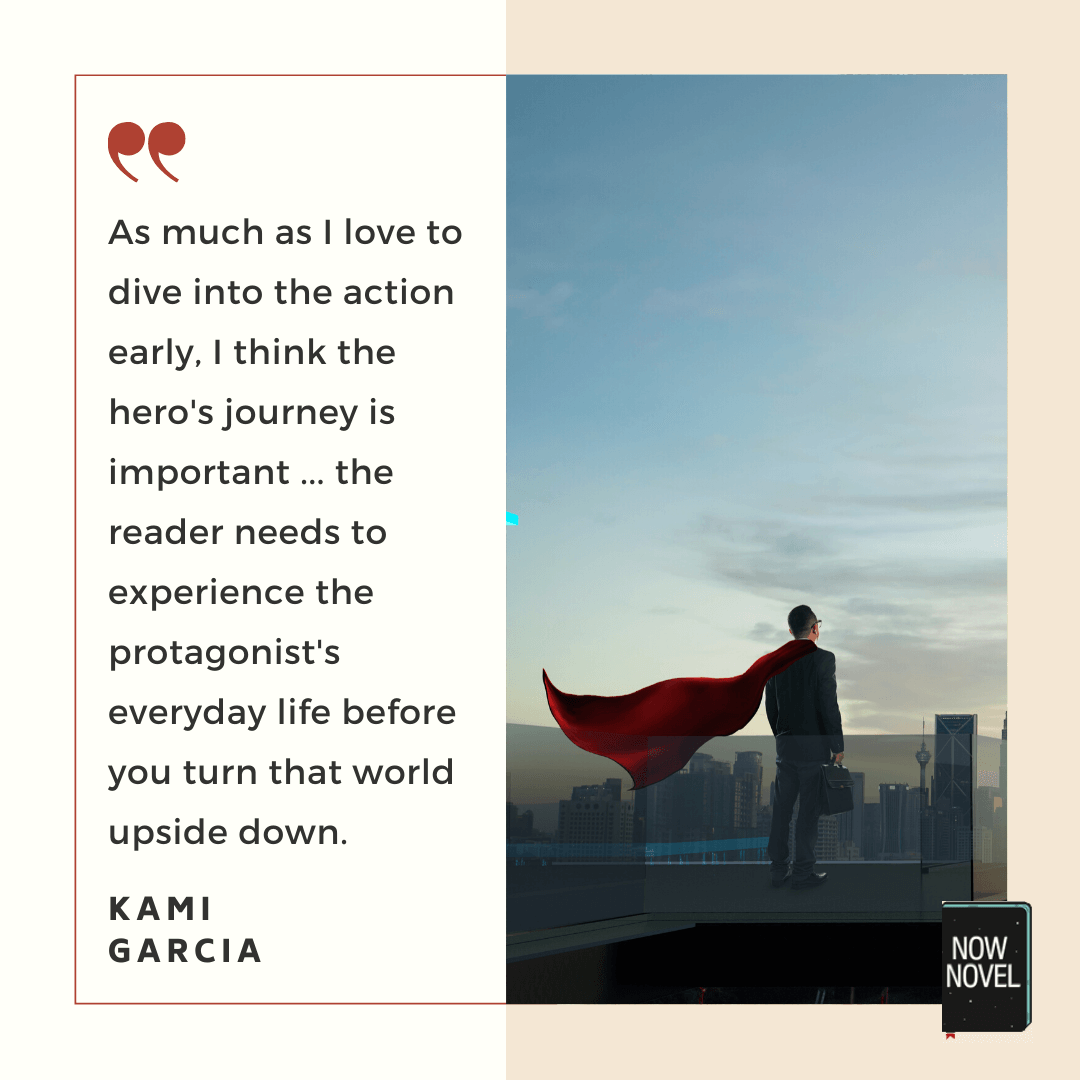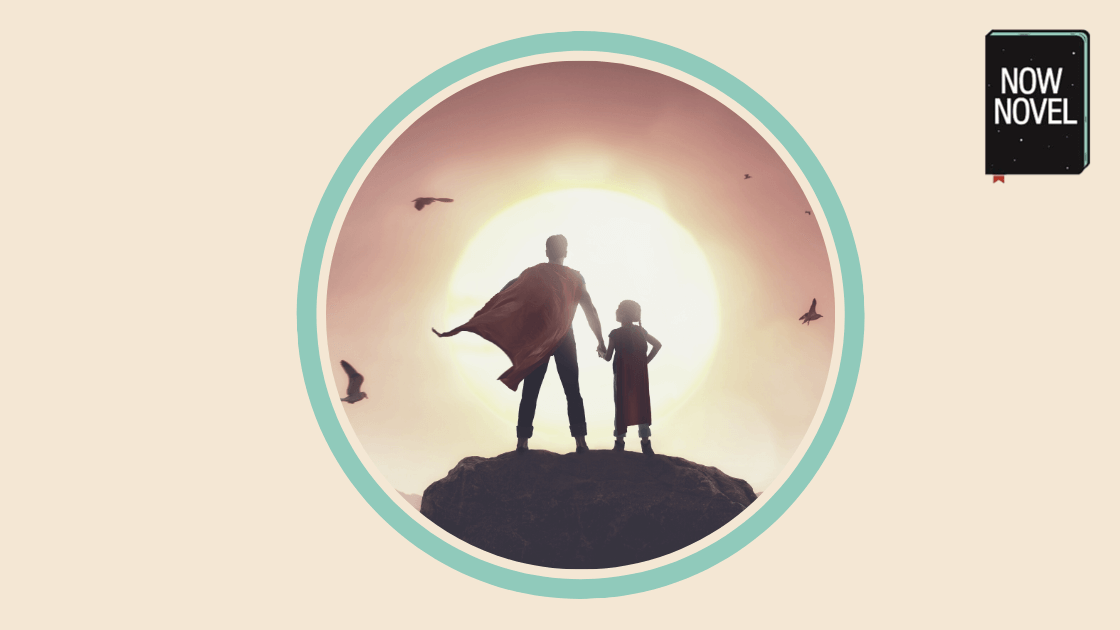The heroic journey is a classic story format. We find heroic quests in all genres. The relentless detective quests for the truth in crime fiction. The fantasy hero quests for knowledge, healing or restored harmony. The plucky whistle-blower quests to bring a corrupt official to justice in a political thriller. Read 8 tips for crafting epic heroic arcs:
1. Know common heroic journey elements
So much has been written about stories involving a heroic journey that there are many theories and ideas to explore.
One of the major theorists of heroic stories is Joseph Campbell, who lectured in comparative mythology and religion. His book Hero with a Thousand Faces (1949) compares the journeys of archetypal heroes we find in many world myths.
UC Berkeley’s resources on Campbell’s heroic journey theories offer a concise summary of some of the stages of the hero’s journey Campbell found common to many myths. We’ve summarized them in the infographic below:

There is also a detailed look at all 17 stages of Campbell’s Hero’s Journey in this post.
2. Think about the shape of a heroic tale
Joseph Campbell’s ‘monomyth’ theory (seeing the way different stories conform to the same patterns) is one way of understanding and outlining stories featuring heroic deeds.
Kurt Vonnegut, author of classic novels such as Slaughterhouse Five speaks instead of the ‘shapes’ of individual stories in this witty 5-minute presentation.
Taking the story of Cinderella as an example, Vonnegut starts by drawing an axis of what he calls ‘The GI axis of ‘good fortune’ and ‘ill fortune’.’ He proceeds to draw graphs of how characters’ arcs in different stories proceed.
This is what he ends up with for Cinderella, a classic ‘tragic hero’ or ‘rags to riches’ tale:

Think about your own story. What will be the small wins represented by the step-like section of the graph (the godmother’s help) be? What will be the big letdown (like the clock’s midnight striking and Cinderella’s fleeing from the ball)?
[Brainstorm interesting goals, setbacks, strengths and flaws for characters using our easy step-by-step outlining tools.]
3. Weave in relevant origins
Nobody is born a hero, just as nobody is born a villain. Experience primes us to make heroic or tragic choices.
Throughout fiction, there are many heroes whose backgrounds help to explain their paths. In Homer’s Odyssey, Odysseus (the protagonist) has already proven himself in battle. His name is already synonymous with heroic excellence. Thus it makes sense that he is equipped with the necessary cunning and sheer endurance to survive his long, meandering route homewards.
In fantasy, the ‘chosen, special orphan’ is a common, even clichéd protagonist. Commonly, they avenge their parents’ death or seek information they were robbed of by their passing.
Yet a skilled author can turn this common backstory into an integral part of a character’s arc. Orphan-heroes read as clichés particularly when they’re only orphaned as a plot device, to enable the adventure.
Instead, make a hero’s origins affect their inner life and development. For example, an orphan on a heroic journey may:
- Find people along the way who become like surrogate family (such as Harry finding Hagrid, Dumbledore and other supportive staff at Hogwarts in J.K. Rowling’s Harry Potter series)
- Have particular fears relating to abandonment or other vulnerabilities linking to their past
If you include backstory, make sure it is relevant in some way to your hero’s own development .
4. Brainstorm amulet-like strengths
There are only so many crystal pendants and other magical talismans one can cram into a story. Think of an amulet or good-luck charm a hero might have in figurative (non-literal) terms, too.
Take for example the hero from Arthurian legend, Percival.
Percival is raised in the woods by his protective mother after his father is killed. Because of this, he is unusually innocent and ignorant of many things in the larger world. This makes him often a laughing stock when he encounters people who have not lived such a sheltered life.
However, because of Percival’s innocence, he has unconventional methods in his approach to trials he faces in the quest for the holy grail. He doesn’t think like the more worldly knights who pursue the same quest. And not having encountered as many fearsome things, he has less (to) fear.
The innocence Percival’s mother ensured him thus becomes like an amulet in its own way.
When writing a heroic journey, think about:
- What unique skills or background your hero brings to the situation (for example, a citizen with a degree in environmental law would be well placed to take on a villainous corporation with harmful ecological practices)
- How a hero’s past or personality affects the way they approach a task or trial
5. Remember to give credible weaknesses
Limitless power in any character is boring because there’s no cost, no suspense, and nothing at stake.
Many of mythology’s memorable heroes have obvious weaknesses. The semi-mortal Greek hero Achilles, for example, from whose story we get the term ‘Achilles’ heel’ meaning a vulnerability that is also a source of downfall (Achilles’ heel is the one point on his body that is not invulnerable).
A hero’s journey is much more engaging when there is a real sense their quest is risky. When enemies lurk within, and not only without.
In Tolkien’s famous Lord of the Rings cycle, each character’s weakness is tested in different ways. Boromir, a warrior from Gondor, though one of Frodo’s protective companions, turns on him and tries to get the One Ring from him out of desperation to save his embattled country (knowing that the ring would grant him greater power).
In this case, Boromir is noble and well-meaning yet corruptible due to how desperately he is committed to his goal (saving his country).
Although heroes tend to be characters who ultimately make the most valiant, noble choices, there can be poor decision-making along the way. This adds tension, as we wonder whether a hero’s character will be up to the task ahead.

6. Give adventure a price (and/or urgency)
It is useful to remember that a heroic journey comes at a price. In Homer’s Odyssey, Odysseus returns home scarcely recognizable to his own wife due to the length of his absence. Suitors have laid siege to the family home, badgering Penelope his wife to remarry.
When a hero is reluctant to answer the ‘call to adventure’, what is the source of their reluctance? This gives a clue regarding the cost of adventure. Maybe they will miss key years in a loved one’s life, as Odysseus does. Maybe they will be powerless to intervene in dire situations back home.
Carrying on tensions back home (as Homer’s epic does) while a hero is absent is a useful way to give the completion of their task greater urgency.
7. Include points of no return
There’s a reason many myths and stories show a point of no return where a heroic journey can’t be abandoned.
It’s the scene where the superhero puts on the power-granting outfit for the first time and experiences true power or liberation. Or the hero crosses the river of the dead to venture into the underworld to retrieve their beloved.
A point of no return or ‘crossing the threshold’ (in Campbell’s terms) is powerful for building momentum, in any story. A scenario from which there is no going back (for example, swearing allegiance to a notorious gang) is naturally full of suspense. Many great epics show heroes venturing into the unknown because it’s the only way back home.
8. Make the climax count
The climax of a heroic journey needs to be a true test. In a political thriller, for example, the ‘bad guys’ perhaps do everything they can to malign and discredit their accuser.
Stacking the odds and unforeseen snags against a hero builds suspense while also avoiding a resolution to an arc that simply feel too easy.
If a hero can teleport to the object of their quest in the last five minutes, for example, readers may well wonder why they didn’t teleport all the way to the finish line from the start. Make every win earned, and be fearless in making heroic figures pay a price for each victory.
Need help developing your character’s heroic journey? Get feedback from peers in Now Novel’s online writing groups or nuanced, professional feedback from a coach.


8 replies on “Writing a heroic journey: 8 tips for epic arcs”
Fantastic post. Thank you very much. regards Cally
Thanks, Cally! Thank you for reading our blog 🙂
This is the first blog I’ve read on here. Thanks for providing other material in addition to Campbell’s work. He is often the go to for anything regarding arcs, but I appreciate the exploration you guys provided into Vonnegut. I definitely look forward to another blog!
It’s a pleasure, Matthew! Thank you for reading our blog.
Do you have any tips for writing hero to villain or villain to hero arcs?
Hi Laney, thank you for your question! Some suggestions would be:
These are just some ideas, I hope they help!
This was very helpful thank you!
I’m a new writer, trying to plan everything out at the moment. Have any advice on building character arcs? Or plot pacing?
Thank you Jessica, I’m glad you found this article helpful! We do, our complete guide to character creation goes into building arcs using goal, motivation and conflict. Here’s something on pacing as well.